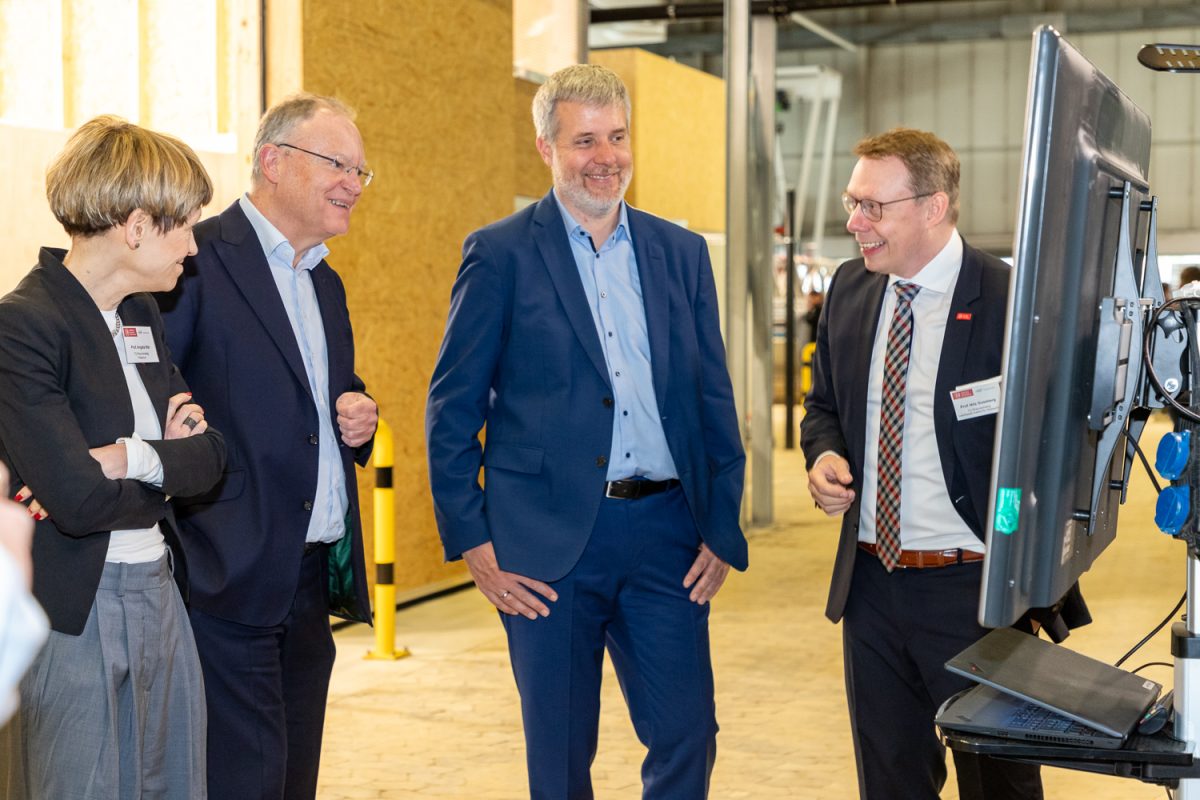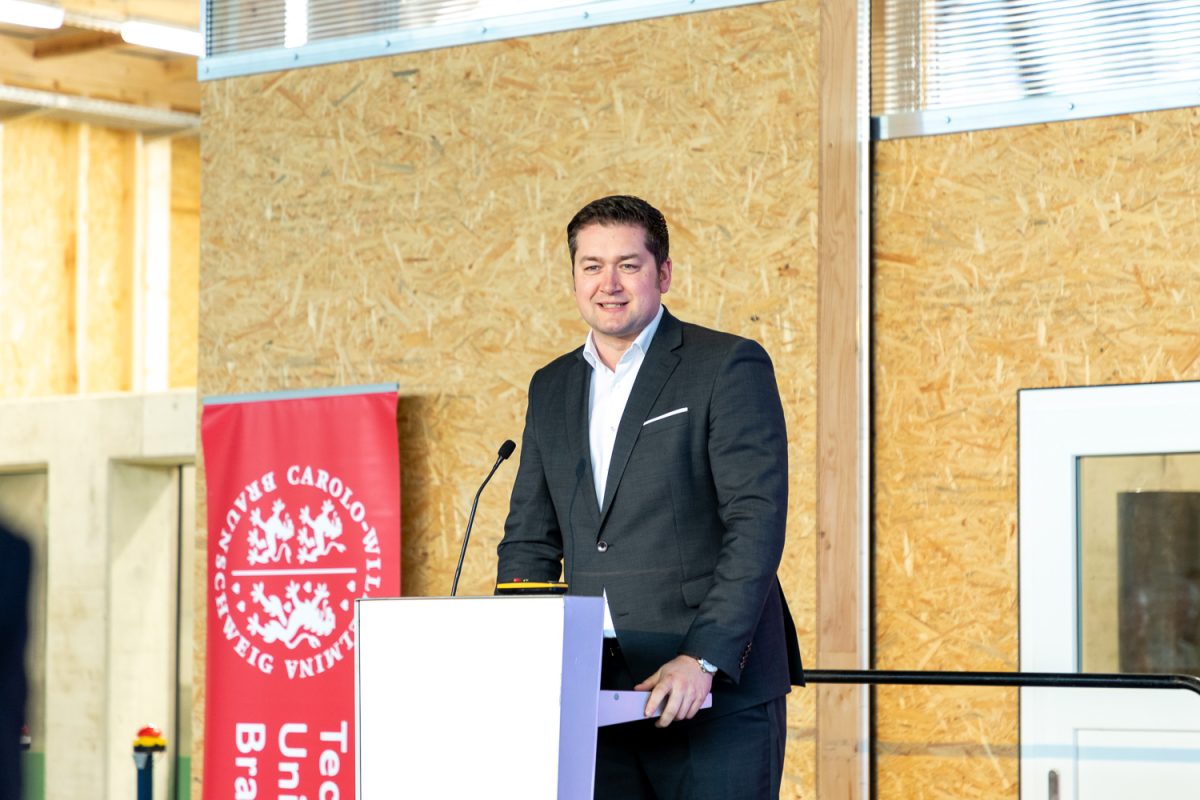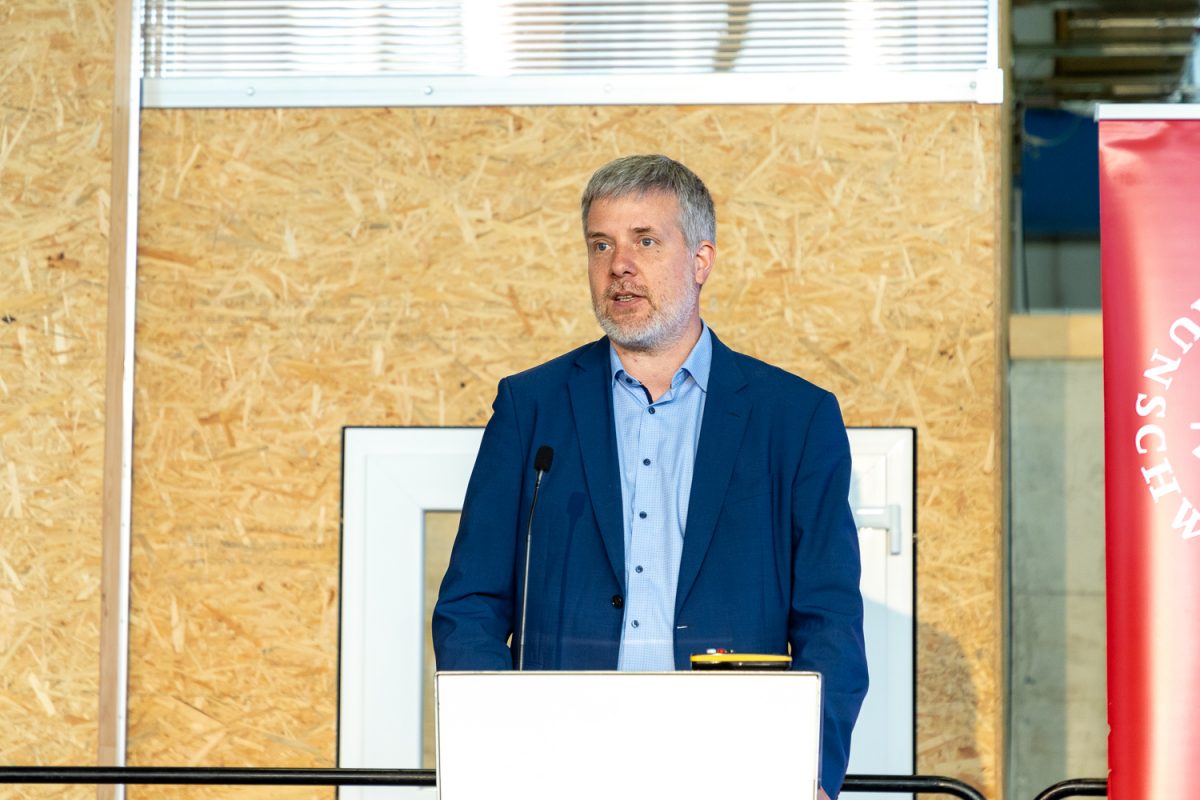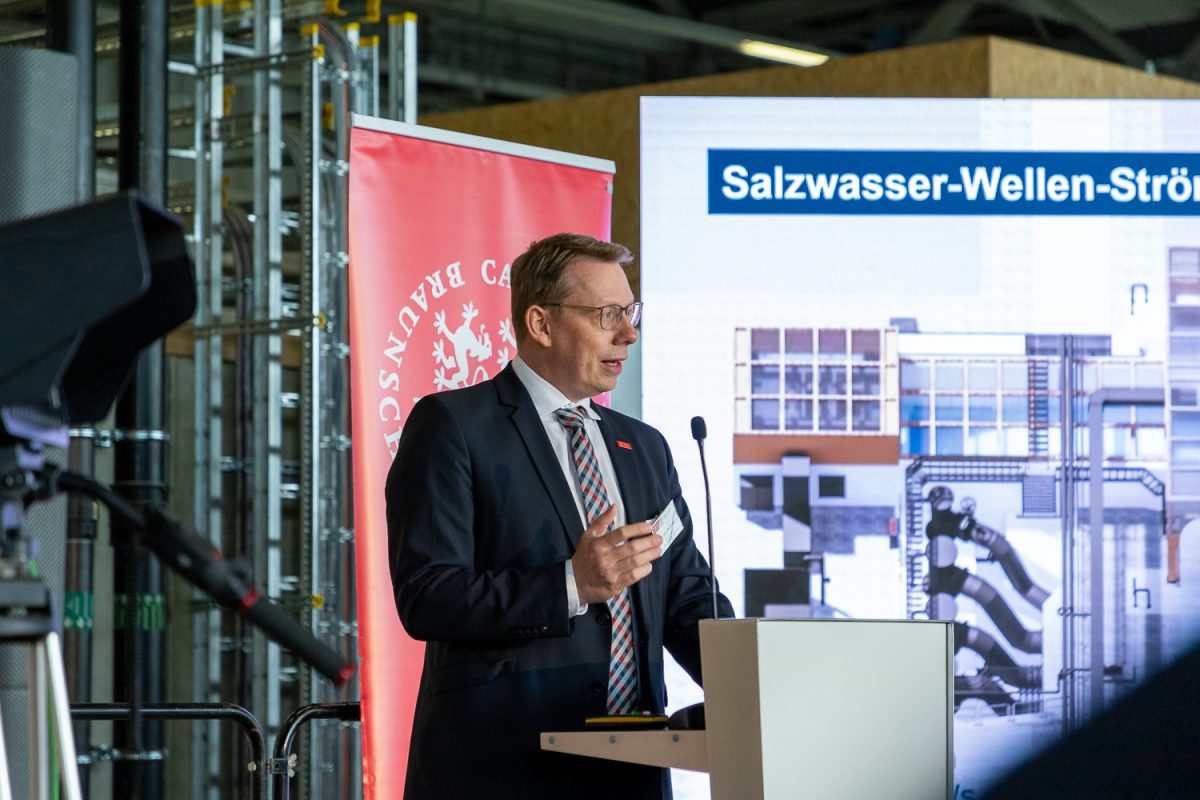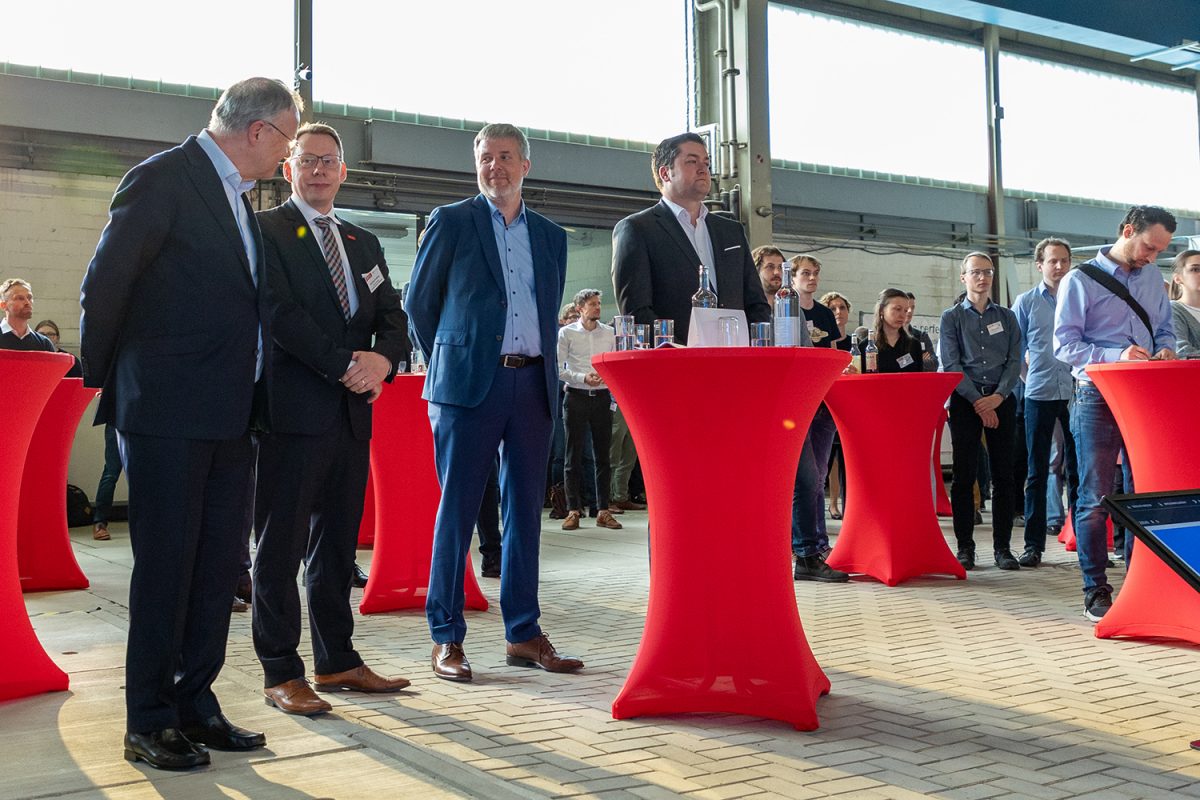Optimal sea conditions in Braunschweig Unique European test facility to support offshore wind research
Offshore wind energy is seen as an important building block for the success of the energy transition. The amount of electricity generated at sea in Germany is expected to increase eightfold by 2045. However, these turbines also face special challenges, such as high exposure to wind and waves, corrosion and colonisation by marine growth. Scientists at Technische Universität Braunschweig want to find out how mussels, algae and other marine organisms affect the load-bearing capacity of offshore wind turbines and other maritime structures. To this end, a new large-scale saltwater research facility, the only one of its kind in Europe, was inaugurated at the Leichtweiß-Institute for Hydraulic Engineering and Water Resources in the presence of Lower Saxony’s Prime Minister Stephan Weil. The aim is to improve the design of offshore wind turbines, reduce high maintenance costs and extend the service life of marine installations.

Inauguration of the new Saltwater Wave-Current Flume at TU Braunschweig (from left): Prof. Nils Goseberg (Leichtweiß-Institute for Hydraulic Engineering and Water Resources), Dieter Janecek (Federal Government Coordinator for Maritime Industry and Tourism), TU-President Prof. Dr. Angela Ittel, Lower Saxony’s Minister President Stephan Weil and Braunschweig’s Mayor Dr. Thorsten Kornblum. Picture credits: Kristina Rottig/TU Braunschweig
Surfaces under seawater are rapidly colonised by marine organisms. Small reefs of mussels, starfish, barnacles and sea anemones form on the support structures and piles of offshore wind turbines. What becomes a new home for marine life, however, affects the loads on the structures caused by sea waves and tidal currents. Although the usual design calculations for wind turbines take into account that the geometry of the underwater structures changes as a result of the vegetation, the effects on the loads acting on them have so far been modelled using conservative estimates due to a lack of precise data.
Strengthening the research base in Hydromechanics, Coastal and Ocean Engineering
The new Saltwater Wave-Current Flume of the Leichtweiß-Institute for Hydraulic Engineering and Water Resources (LWI) at TU Braunschweig, which is part of the “EnviSim4Mare” project funded by the German Federal Ministry for Economic Affairs and Climate Action (BMWK), now enables measurements under real environmental conditions for the first time. In addition to the Large Wave Current Flume (GWK+) of the Coastal Research Centre of TU Braunschweig and the Leibniz University Hannover, another unique research facility in Europe has now been added, which once again decisively strengthens the unique position of the Braunschweig-Hannover research location in the fields of Hydromechanics, Coastal and Ocean Engineering and Maritime Technologies and expands the already very extensive portfolio of small and large-scale experimental facilities.
“We can model the entire marine environment here and use special measurement technology to gain a precise insight into the processes that take place around the structures covered with marine growth in the sea,” says Professor Nils Goseberg, Managing Director of LWI. “We can control the temperature, pH value, salinity and oxygen in the system. This gives us the opportunity to include living marine life and to model the interaction of the offshore wind turbine with its environment.”
Braunschweig water becomes seawater
As the name suggests, the 30 metre long and three metre wide channel combines salt water, waves and currents. The two built-in wave machines can generate waves up to 80 centimetres high. Four pumps also provide the current. The system is also equipped with a water treatment system. To reduce the use of fresh water and to regulate the required water conditions, the water is treated and reused in a closed circuit. The LWI team transforms normal Braunschweig water into seawater by feeding sea salt brine into the water treatment plant. “This allows us to provide the mussels with optimal marine conditions – similar to those in the North and Baltic Seas,” explains Dr. David Schürenkamp, senior engineer in the Hydromechanics, Coastal and Ocean Engineering department at LWI.
The three-stage filtration system includes a sand filter, a skimmer with ozone treatment and a biological trickle filter. The water treatment system can purify up to 350 cubic metres, or 350,000 litres, of salt water per hour. A separate holding tank will be used for the marine organisms – mussels, barnacles and algae – that have been grown on test beds at offshore sites around Helgoland and at the Nordergründe wind farm in the North Sea. Here they will slowly acclimatise to the conditions in the saltwater wave current channel.
View through the underwater window
The scientists are about to start their first experiments. They will be able to observe and document them from the control room, using several cameras in the facility and a large underwater window that will allow the researchers to look into the flume as if in an aquarium.
Not much of the canal itself can be seen in the test hall. It has been given an enclosure that can be closed with sliding elements for the experiments. “This gives us ideal conditions,” says Professor Goseberg. “The right humidity and temperature are maintained in the air and water, allowing us to carry out energy-efficient and sustainable research.”
Further research projects are planned to follow on from the “EnviSim4Mare” project. “Due to the increasing use of marine areas, research activities on the functionality and optimisation of maritime technologies will increase, while at the same time the need for technology assessment at the interface with the marine environment will become more relevant,” says Professor Goseberg. Possible next study topics could be, for example, marine fouling on ships or the interaction of ecology, waves and currents in the Wadden Sea.
EnviSim4Mare
The test facility is part of the “EnviSim4Mare” project funded by the Federal Ministry for Economic Affairs and Climate Action (BMWK) with a total of around 8.79 million euros. The Leichtweiß Institute of TU Braunschweig, Department of Hydromechanics, Coastal and Ocean Engineering, will receive 7.86 million euros of the total funding for its sub-project. The planning and construction costs of the research facility account for around seven million euros of this. In addition to the Leichtweiß Institute for Hydraulic Engineering and Water Resources, the Alfred Wegener Institute Helmholtz Centre for Polar and Marine Research (AWI) and the company Jörss-Blunck-Ordemann GmbH as well as other associated industrial partners and authorities are also involved.
Comments on the research facility
Prof. Dr. Angela Ittel, President of Technische Universität Braunschweig
“The opening of the flume is an important day for our university, but even more importantly for the scientists who have worked so enthusiastically on this project. Our research at the Leichtweiß-Institute for Hydraulic Engineering and Water Resources as a whole, and in particular our work on the Saltwater Wave-Current Flumr, underlines our clear commitment to sustainability and the excellent achievements of our researchers. The current and future research topics directly contribute to energy security and future climate neutrality in Germany.”
Stephan Weil, Minister President of Lower Saxony
“The new Saltwater Wave-Current Flume is a unique test and research facility in Europe. The knowledge gained here will further optimise the planning and construction of offshore wind turbines and thus accelerate the expansion of offshore wind power. In addition to the “GWK+” Large Wave-Current Flume in Hanover, the Saltwater Wave-Current Flume in Braunschweig is another beacon for Lower Saxony as a science location and is certainly a milestone for coastal engineering in Lower Saxony and Germany – future-oriented research made in Lower Saxony.”
Dr. Thorsten Kornblum, Mayor of the City of Braunschweig
“The new Saltwater Wave-Current Flume at Technische Universität Braunschweig is an impressive example of how solutions for the challenges of the future are being sought in Braunschweig. With this research facility, which is unique in Europe, our science region is setting an important example of forward-looking research. In the future, wind energy will play a central role in our electricity supply from renewable sources. TU Braunschweigs’s research results will make an important contribution to the optimisation of offshore wind turbines.“
Dieter Janecek, Federal Government Coordinator for the Maritime Industry and Tourism
“Offshore wind energy is now a key cornerstone of the energy transition, providing green electricity to millions of people. However, we need to further accelerate the construction of new wind farms on the way to climate neutrality. The Federal Government will do everything in its power to speed up approval procedures and boost the production of converter platforms in Germany. At the same time, as part of our support for maritime research, we are stepping up the development of new offshore technologies and their ability to withstand harsh environmental conditions, which can be studied with the innovative large-scale research facility. This will also help to increase offshore wind capacities.”
Nils Goseberg, Professor of Hydromechanics, Coastal and Ocean Engineering, Technische Universität Braunschweig
“With the Saltwater Wave-Current Flume, we can now for the first time monitor all the key environmental parameters for the exposure of marine technologies in the sea in a test facility and on a very large length scale. This is a decisive step towards synthesising the use and protection of our oceans. In addition to the costly observation of nature in our oceans from research vessels, we can now study the influence of the sea and its forces on the facilities and vice versa under defined laboratory conditions on land.“


